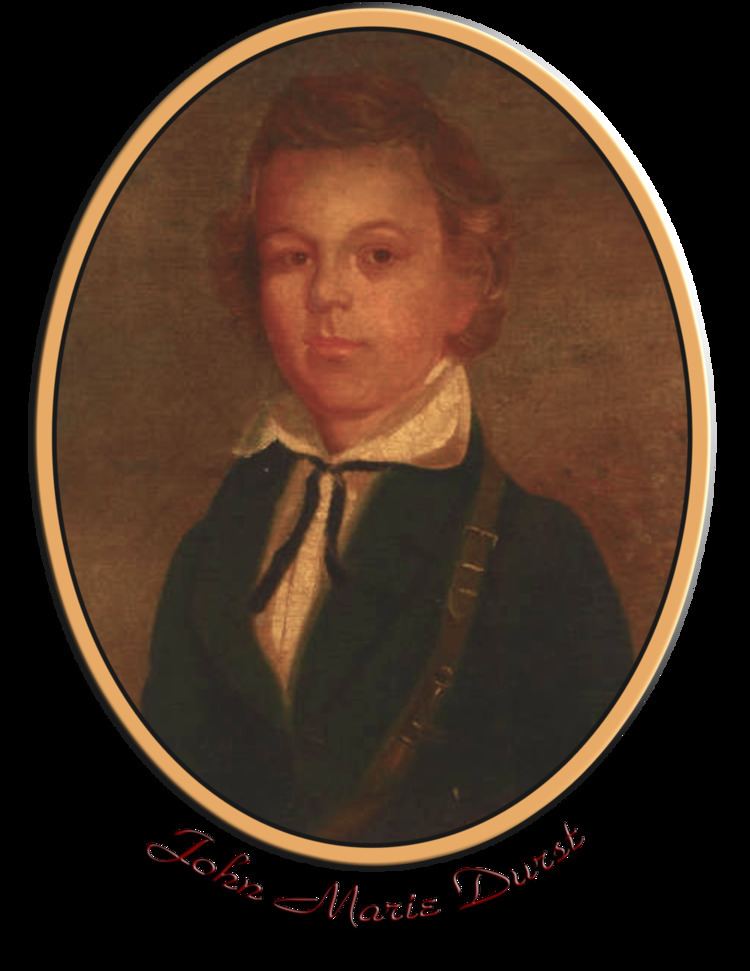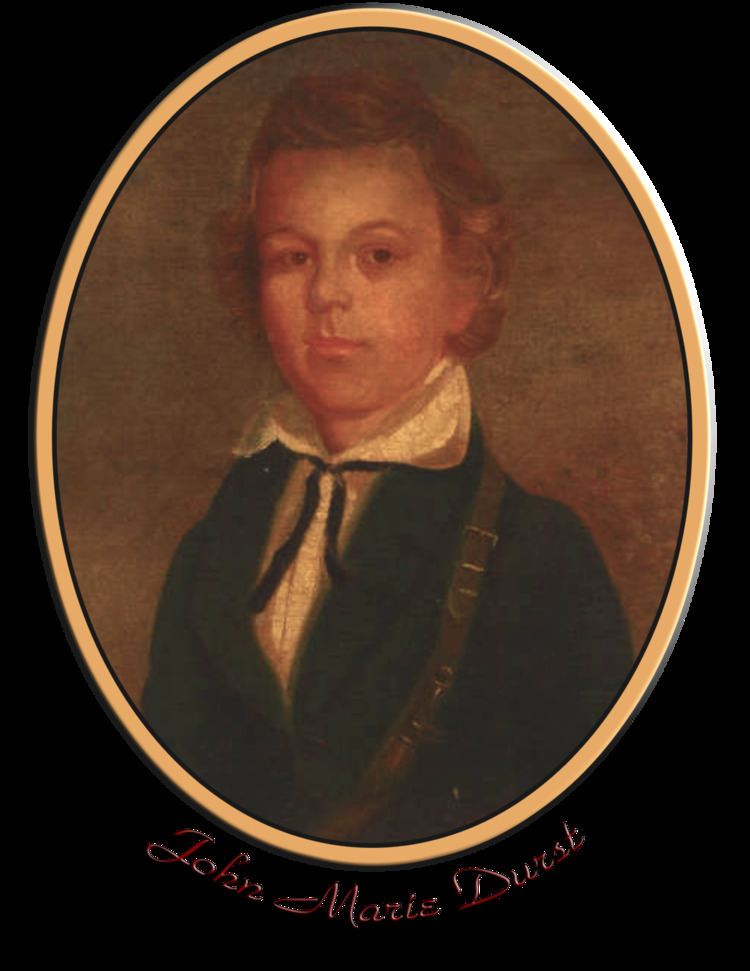Nationality American Name John Durst | Spouse Harriet Jamison (m. 1821) | |
 | ||
Resting place Durst CemeteryLeon County, Texas31°09′35″N 95°56′36″W / 31.15972°N 95.94333°W / 31.15972; -95.94333Coordinates: 31°09′35″N 95°56′36″W / 31.15972°N 95.94333°W / 31.15972; -95.94333 Children Louis Orlando (1827–1859)Mary Benigna (1830–1854)Charles Placide (1832–1905)Alexander H (1834–1840)Angelina Anna (1837–1841)Harriet Matilda (1839–1871)John Sterling (1841–1924)Horatio Walter (1844–1930)Clara Elizabeth (1846–1856)Eugene Marcelino (1849–1849) Parents Jacob Durst, Anna Agnes Schesser Durst | ||
John Marie Durst (1797–1851) was an early settler who lived most of his life in Louisiana and Texas. He was a multi-linguist who learned the mercantile trade from his godfather Peter Samuel Davenport. Durst was a veteran of the Battle of New Orleans. He was a legislative representative under Coahuila y Tejas, during which he became involved in a land speculation controversy. Durst became a large land holder, due in part to an inheritance from Davenport. Because of a ride he made in 1835 to warn of Mexican troop movements, some have labeled him the Paul Revere of Texas. Durst was a Captain in the Republic of Texas militia under Major General Thomas J. Rusk. He was the founder of the community of Mount Sterling, Texas in Nacogdoches County..
Contents
- Early life
- Peter Samuel Davenport
- Battle of New Orleans
- Land owner
- Coahuila y Tejas
- Republic of Texas
- Personal life and death
- References

Early life
John Marie Durst was born in Arkansas Post on February 4, 1797. He was one of eight children, four boys and four girls, born to Jacob and Anna Agnes (Schesser) Durst. His brother John Isaac shared his first name. His father Jacob had been born in Shenandoah County, Virginia in 1754. Jacob's father Abraham Derst spelled the family name with an "e". Abraham Derst was born in Worms-Pfeddersheim, Germany in 1725, and became the family member who emigrated to Virginia. Abraham's father Abraham Jacob Derst was born and died in Germany. When John was two years old, his mother died. John's father Jacob Durst moved the entire family to Natchitoches, Louisiana in 1803.
Peter Samuel Davenport
In 1806, Jacob Durst moved to Nacogdoches, Texas with son John Marie and two of his brothers. Jacob died in 1814, and local merchant Peter Samuel Davenport, known to friends as Samuel, became John's godfather and legal guardian.
The other two sons had already reached adulthood. Nacogdoches merchants William Barr, Luther Smith, Edward Murphy and Davenport had established the mercantile House of Barr and Davenport in 1798. During Spanish Texas, the distribution center was an importer and exporter of merchandise between Louisiana and Texas, servicing both the Spanish troops and the area Indian tribes. Under Davenport's guardianship, the young Durst learned the mercantile trade and became fluent in several languages, including those of Indian tribes among whom the House of Barr and Davenport maintained resident traders. When the Gutiérrez-Magee Expedition captured Nacogdoches on August 12, 1812, Davenport became the quartermaster for the filibuster, supplying both arms and materiel, as well as rallying volunteers to join the cause. With the expedition defeated the next year, the Spanish government offered a reward for his capture. Davenport fled to Natchitoches, accompanied by Durst.
Battle of New Orleans
On January 8, 1815, Durst participated in the Battle of New Orleans, as part of the Louisiana militia, second division. At the end of the battle, Durst returned to Natchitoches.
Land owner
Davenport died in 1824. His will left 10,000 acres (40.47 km2; 15.63 sq mi) acres in Louisiana to Durst. Davenport's son Juan Benigno swapped Durst the Louisiana acreage for acreage on the west side of the Sabine River in Texas. Part of the sale included the Old Stone Fort in Nacogdoches, which Durst owned until 1834, when he sold it to Juan Mora and Vicente Córdova.
In April 1834 Durst received a Mexican land grant for five leagues, which was surveyed in three separate tracts in Houston, Nacogdoches and Anderson counties. Durst had originally petitioned for land to be located on the eastern margin of the Trinity River. He was likely trying to recover the Barr Rancho, a large tract lost by his adoptive-father Samuel Davenport [successor to the landholdings of the only official Indian trading establishment licensed by the Spanish government in the Province of Texas, known as the House of Barr and Davenport], which had been confiscated by the government in 1813 due to Davenport's participation in the Gutiérrez-Magee Expedition. Durst had doubtlessly spent many fond visits and vacations during his adolescent years at the Barr Rancho. But the Alcalde of Nacogdoches, Juan Maria Mora, stated that while there was sufficient uncultivated lands he could choose from, large unclaimed tracts still available on the east bank of the river were limited to those "two leagues below [downriver from] the Old Presidio [Trinidad de Salcedo] and two leagues above [upriver from] the same."
Durst chose a tract "above" the former location of Trinidad de Salcedo, astride the road to Bexar [Old San Antonio Road] that surveyed-out to three leagues, plus 18 labors. Interestingly, there was a call in the fieldnotes of this survey for the northern corner to fall on the "Arroyo de las Ruinas" [Ruins Creek], likely a namesake gained from the ruins of the old Barr Rancho headquarters, burnt by order of Col. Ignacio Elizondo, of the Spanish Royal Army, during his "mopping-up" operations against disloyal subjects in the aftermath of the Gutierrez-Magee Expedition and the rout of the insurgents at the Battle of Medina on 18 August 1813.
Coahuila y Tejas
From 1829 to 1834, Durst served in many capacities as an interpreter, and became active in politics. In 1835, Durst became a legislative representative of Coahuila y Tejas from Nacogdoches. He became involved in a controversy over land speculation.
While at the legislature, Durst learned of Mexican troop movement into Texas, and became known as the Paul Revere of Texas for his subsequent ride warning of the movement.
Republic of Texas
In 1837, Durst founded the town of Mount Sterling in Nacogdoches County.
In 1838, Durst held the rank of Captain in the Republic of Texas militia, serving under Major General Thomas J. Rusk, during Rusk's campaign involving the Kickapoo and Cherokee tribes. In 1844, Durst moved to Leon County.
Personal life and death
Durst married Harriet Matilda Jamison on February 15, 1821. John Henninger Reagan, at the time a deputy surveyor, served as a private tutor to the Durst children. John Marie Durst died in Galveston on February 9, 1851 and is buried in the family cemetery in Leon County. His wife died September 23, 1885 and is buried next to him.
